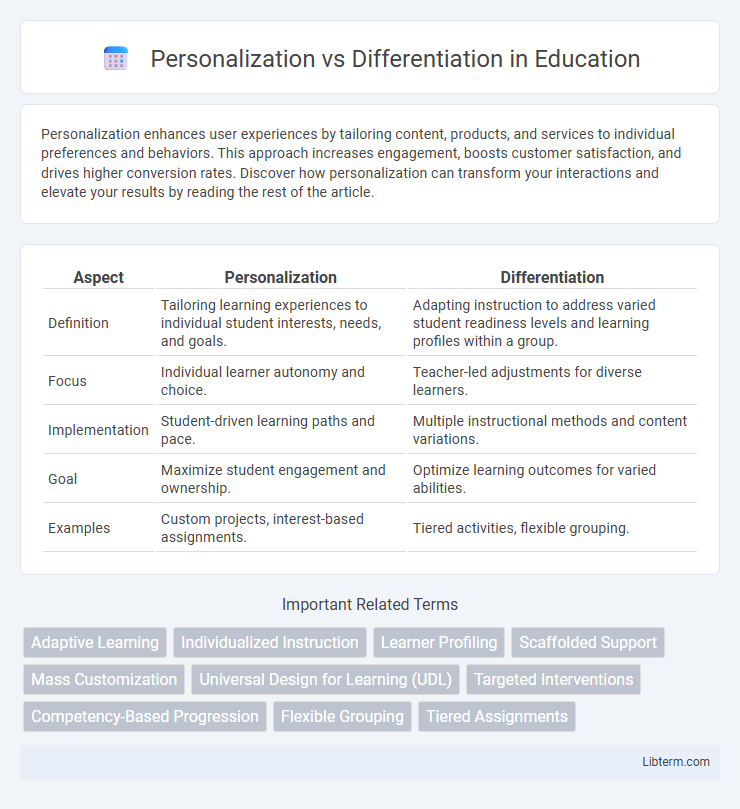Personalization enhances user experiences by tailoring content, products, and services to individual preferences and behaviors. This approach increases engagement, boosts customer satisfaction, and drives higher conversion rates. Discover how personalization can transform your interactions and elevate your results by reading the rest of the article.
Table of Comparison
| Aspect | Personalization | Differentiation |
|---|---|---|
| Definition | Tailoring learning experiences to individual student interests, needs, and goals. | Adapting instruction to address varied student readiness levels and learning profiles within a group. |
| Focus | Individual learner autonomy and choice. | Teacher-led adjustments for diverse learners. |
| Implementation | Student-driven learning paths and pace. | Multiple instructional methods and content variations. |
| Goal | Maximize student engagement and ownership. | Optimize learning outcomes for varied abilities. |
| Examples | Custom projects, interest-based assignments. | Tiered activities, flexible grouping. |
Understanding Personalization and Differentiation
Personalization tailors learning experiences to individual student preferences, strengths, and interests, enabling customized pacing and content delivery. Differentiation modifies teaching strategies and materials within a group to address diverse learning needs, ensuring all students access the curriculum effectively. Understanding the distinctions between personalization and differentiation helps educators implement targeted approaches that optimize student engagement and achievement.
Key Differences Between Personalization and Differentiation
Personalization tailors content, learning pace, and resources to individual student preferences and needs, while differentiation adapts instruction to diverse learner groups within a classroom based on readiness, interests, or learning profiles. Personalization often leverages technology and data analytics to customize experiences on a student-by-student basis, whereas differentiation involves varied teaching strategies and materials for groups. Understanding these distinctions enhances instructional design by aligning the appropriate approach with educational goals and learner diversity.
The Role of Technology in Personalization
Technology enables precise data collection and analysis, allowing personalized learning experiences tailored to individual student needs, preferences, and progress. Adaptive learning platforms utilize artificial intelligence to modify content and pace, enhancing engagement and comprehension. This personalized approach contrasts with differentiation, which adjusts teaching strategies for groups but lacks the granular customization technology provides.
Differentiation Strategies in Modern Education
Differentiation strategies in modern education target diverse learning needs by tailoring content, process, and product based on student readiness, interests, and learning profiles, enhancing engagement and academic outcomes. Techniques such as tiered assignments, flexible grouping, and varied instructional methods support individualized pacing and depth, fostering inclusive classrooms that address heterogeneous learner populations. This approach contrasts with personalization by emphasizing varied teaching approaches within a common curriculum rather than fully individualized paths, promoting equity and maximizing student potential.
Benefits of Personalization for Learners
Personalization boosts learner engagement by tailoring content to individual interests, learning styles, and paces, which enhances comprehension and retention. It enables targeted feedback and adaptive support, addressing specific strengths and weaknesses to promote mastery and confidence. Personalized learning pathways foster motivation and autonomy, empowering learners to take ownership of their educational journey.
Challenges of Implementing Differentiation
Implementing differentiation in education faces challenges such as increased teacher workload, requiring significant planning and resource allocation to address diverse student needs effectively. Limited teacher training and lack of administrative support often hinder the consistent application of differentiated strategies across classrooms. Furthermore, balancing standardized curriculum demands with tailored instruction complicates assessment and progress monitoring.
Impact on Student Engagement and Outcomes
Personalization tailors instruction to individual student interests, learning styles, and pace, significantly boosting engagement by making content relevant and accessible. Differentiation adapts teaching methods and materials to diverse student needs within a group, enhancing outcomes by addressing varied skill levels and readiness. Both strategies improve educational success, with personalization fostering deeper motivation and differentiation ensuring inclusive support.
Personalization vs Differentiation: Which Is More Effective?
Personalization customizes learning experiences to individual student needs, preferences, and interests, enhancing engagement and motivation. Differentiation adapts instruction to diverse student abilities within the same classroom environment, allowing tailored content and pacing. Studies suggest personalization often yields more significant gains in student achievement by providing specific support and challenges aligned with each learner's profile.
Real-World Examples of Each Approach
Personalization in education uses tailored learning experiences exemplified by platforms like Khan Academy, which adapts lessons based on individual student performance data. Differentiation involves modifying instruction to cater to diverse learner needs within a classroom, demonstrated by teachers assigning varied reading materials based on students' proficiency levels. Both approaches aim to enhance student engagement and achievement but differ in their implementation of individualized versus group-based strategies.
Future Trends in Personalized and Differentiated Learning
Future trends in personalized and differentiated learning emphasize adaptive technologies powered by artificial intelligence, enabling real-time customization of educational content based on individual learner profiles and performance metrics. Data analytics and machine learning algorithms will increasingly facilitate tailored learning pathways, enhancing engagement through dynamic content adjustments and predictive assessments. Emerging virtual and augmented reality tools are expected to support immersive, differentiated experiences that cater to diverse learning styles and accessibility needs.
Personalization Infographic

 libterm.com
libterm.com